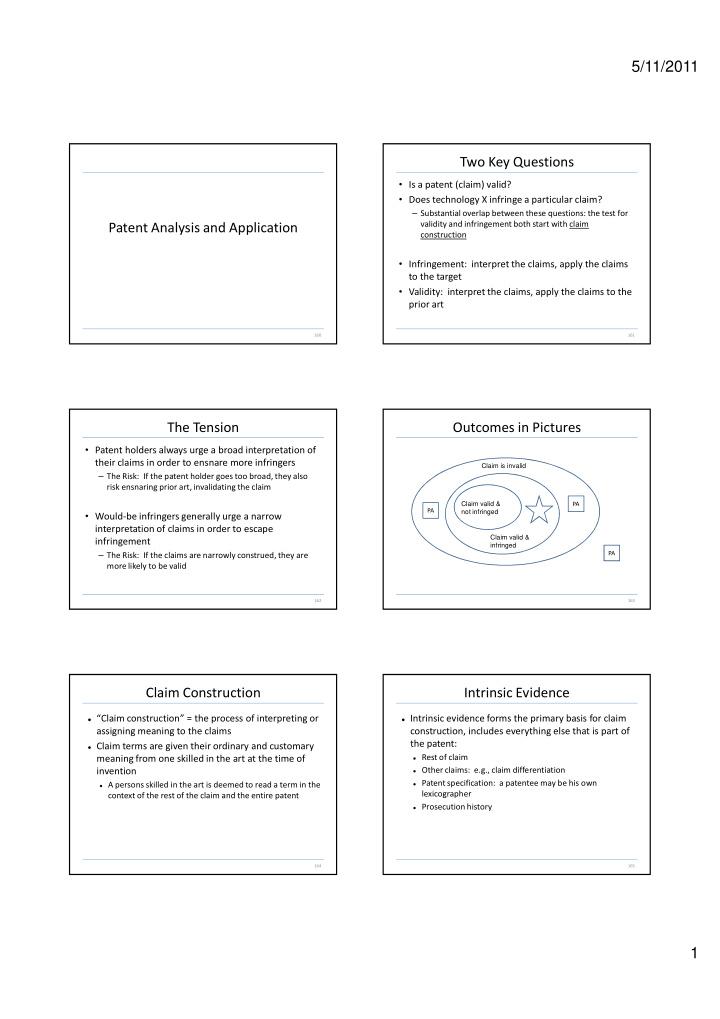



5/11/2011 Two Key Questions • Is a patent (claim) valid? • Does technology X infringe a particular claim? – Substantial overlap between these questions: the test for validity and infringement both start with claim Patent Analysis and Application construction • Infringement: interpret the claims, apply the claims to the target • Validity: interpret the claims, apply the claims to the prior art 160 161 The Tension Outcomes in Pictures • Patent holders always urge a broad interpretation of their claims in order to ensnare more infringers Claim is invalid – The Risk: If the patent holder goes too broad, they also risk ensnaring prior art, invalidating the claim Claim valid & PA PA not infringed • Would-be infringers generally urge a narrow interpretation of claims in order to escape Claim valid & infringement infringed PA – The Risk: If the claims are narrowly construed, they are more likely to be valid 162 163 Claim Construction Intrinsic Evidence � “Claim construction” = the process of interpreting or � Intrinsic evidence forms the primary basis for claim assigning meaning to the claims construction, includes everything else that is part of the patent: � Claim terms are given their ordinary and customary � Rest of claim meaning from one skilled in the art at the time of invention � Other claims: e.g., claim differentiation � Patent specification: a patentee may be his own � A persons skilled in the art is deemed to read a term in the lexicographer context of the rest of the claim and the entire patent � Prosecution history 164 165 1
5/11/2011 Claim Differentiation Claim Differentiation 1. A method of packing a lunch, comprising: 1. An apparatus comprising: … a memory … selecting a fruit; making a sandwich; and 2. The apparatus of claim 1 wherein the memory is a packing the fruit and sandwich in a container. fixed disk drive. 2. The method of claim 1 wherein selecting the fruit • Claim 1 is by definition broader than claim 2, thus “memory” includes fixed disks and other storage includes picking a fruit from a tree. devices. 166 167 Prosecution History Extrinsic Evidence � Statements made during prosecution can and will be � Less significant than intrinsic evidence used during claim construction � Dictionaries � Estoppel: The patentee cannot urge one � Treatises interpretation (usually a narrow one) to obtain a � Expert testimony patent, and then urge another interpretation (usually a broad one) during enforcement � Example: “the term ‘mobile device’ does not include laptop computer” � Patentee cannot later claim that “mobile device” includes laptops… 168 169 Infringement Analysis Different Types of Infringement • Interpret claims • Literal infringement • Read claims in light of technology – Accused device literally performs/includes each and every aspect of the claim • If a parent claim is not infringed, then by definition its dependent claims cannot be infringed • Non-literal infringement (Doctrine of Equivalents) – – If the independent claim is not infringed, then none of its may still infringe if there are “insubstantial children are differences” • Infringement must be shown by a preponderance of – Differences are insubstantial if the accused device the evidence performs substantially the same function, in substantially the same way, to achieve substantially the same result 170 171 2
5/11/2011 Direct/Indirect Basis for invalidity • Direct infringement � Bases for invalidity, in decreasing order of value… – E.g., Accused performs each step of the a method � Anticipation with “killer” 102(b) prior art – a single reference teaches all of the claim limitations • Indirect infringement � Anticipation with other prior art – Contributory infringement : selling an article that does not � Obviousness using 102(b) prior art – multiple combined by itself infringe, but (1) infringes in combination with references teach all of the claim limitations other parts, (2) accused knows article to be especially adapted for infringement, and (3) is not a staple article of � Obviousness with other prior art commerce having substantial non-infringing uses � Subject matter – the claims are not directed to patentable – Induced infringement: knowingly causing direct subject matter infringement by another � Indefiniteness – we cannot ascertain the boundaries of the • “Joint infringement” claim – Cannot occur without control by one party 172 173 Prior Art Invalidity Analysis Invalidity: A process • Interpret claims � Process: � Interpret claims (read patent, file history, etc.) • Read claims in light of one or more prior art references � Determine effective filing date of claimed subject matter: wade through priority chain • If a parent claim is not valid, its dependent claim may � Determine the “critical date” = one year before effective still be valid (because they are narrower) filing date • Invalidity must be shown by clear and convincing � Search for prior art evidence � Read claims on the prior art 174 175 Invalidity: Claim charts Legal Opinions • When you placed “on notice,” you may be liable for Claim Aspect Citation treble damages due to “willfull infringement” 1. A computer-implemented method for Ref X, p. 1 • To protect against this, parties frequently obtain legal sorting data, comprising: opinions stating that: receiving an indication of an array of Ref X, p. 2 values; – The patent claims are not infringed, and/or partitioning the array; Ref X, p. 2 – The patent claims are invalid (and thus cannot be recursively sorting the array. Ref X, p. 2 infringed) 2. The method of claim 1, further Ref Y. p. 7 comprising: iteratively sorting the array • If the claims are valid and infringed, no choice but to when it is shorter than a specified size. take a license or design around 176 177 3
Recommend
More recommend